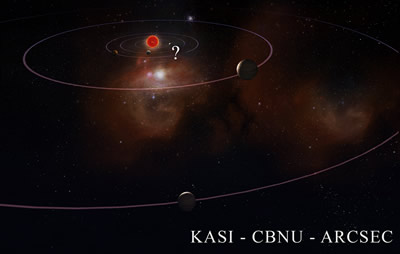Jupiter's Statistics
| Planetary Symbol: |
 |
Name in Roman/Greek Mythology: |
Jupiter/Zeus |
| Diameter: |
142,800 km
(88,736 miles) |
Rotation Period about Axis: |
9.8 hours |
| Mass: |
1,898 x10^24 kilograms (318 x Earth's) |
Revolution Period about the Sun: |
12 years |
| Density: |
1,326 kg/m^3 |
Tilt of Axis: |
3.1o |
| Minimum Distance from Sun: |
741 million km
(460 million miles) |
Surface Gravity: |
23.12 m/s^2 (2.64 x Earth's) |
| Maximum Distance from Sun: |
817 million km
(508 million miles) |
Distance across the Great Red Spot: |
40,000 km
(24,860 miles) |
| Orbital Semimajor Axis: |
5.20 AU (Earth=1 AU) |
Temperature at Cloud Tops: |
-150o C (-101o F) |
| Minimum Distance from Earth: |
588 million km
(365 million miles) |
Average Cloud Top Temperature (K): |
123K |
| Rings: |
1, very thin |
Satellites: |
known |
 Jupiter Image Archive
Jupiter Image Archive
 Comparative Planetary Statistics -- in table form
Comparative Planetary Statistics -- in table form
 Comparative Orbital Statistics -- in table form
Comparative Orbital Statistics -- in table form
 Actual Distance to Earth
Actual Distance to Earth
 News from NSF: A Newly Discovered Solar System Contains Scaled-Down Versions of Saturn and Jupiter (2/14/08)
News from NSF: A Newly Discovered Solar System Contains Scaled-Down Versions of Saturn and Jupiter (2/14/08)
 Podcasts from NSF: Systemic Search
Podcasts from NSF: Systemic Search
You might also be interested in:

For a long time, scientists have wondered if there are other systems of planets like our own in our galaxy. Recently scientists discovered a solar system that has smaller versions of Jupiter and Saturn.
...more
Anthony Wesley is an astronomer in Australia. One night in July 2009, Wesley noticed a dark spot on Jupiter that hadn't been there before. He had discovered the remains of a huge impact on Jupiter! A comet
...more
Jupiter is the biggest planet in our solar system! It's also very bright in the sky. We don't know who discovered it, but we do know the ancient Greeks named the planet after the god, Zeus. The United
...more
Jupiter's magnetosphere is very special. It is the biggest thing in the entire solar system. Not only is it big enough to hold all of Jupiter's moons, but the sun itself could fit inside. It goes all
...more
You may think Saturn is the only planet with rings. It is not! Jupiter has rings, too. They aren't as easy to see as Saturn's, but they are there! Saturns rings are made of ice and are very bright. Jupiter's
...more
The giant planets have definitely changed since their formation. But how much remains to be seen. Most of the original air of the giant planets remains in place. (The earth-like planets lost most of their
...more
The mesosphere of Jupiter is a region of balance between warming and cooling. That essentially means that nothing happens there. Except for diffusion, the atmosphere is still. Upper reaches of the atmosphere,
...more

 Comparative Planetary Statistics -- in table form
Comparative Planetary Statistics -- in table form
 Comparative Orbital Statistics -- in table form
Comparative Orbital Statistics -- in table form
 News from NSF: A Newly Discovered Solar System Contains Scaled-Down Versions of Saturn and Jupiter (2/14/08)
News from NSF: A Newly Discovered Solar System Contains Scaled-Down Versions of Saturn and Jupiter (2/14/08)
 Podcasts from NSF: Systemic Search
Podcasts from NSF: Systemic Search


 Jupiter Image Archive
Jupiter Image Archive











